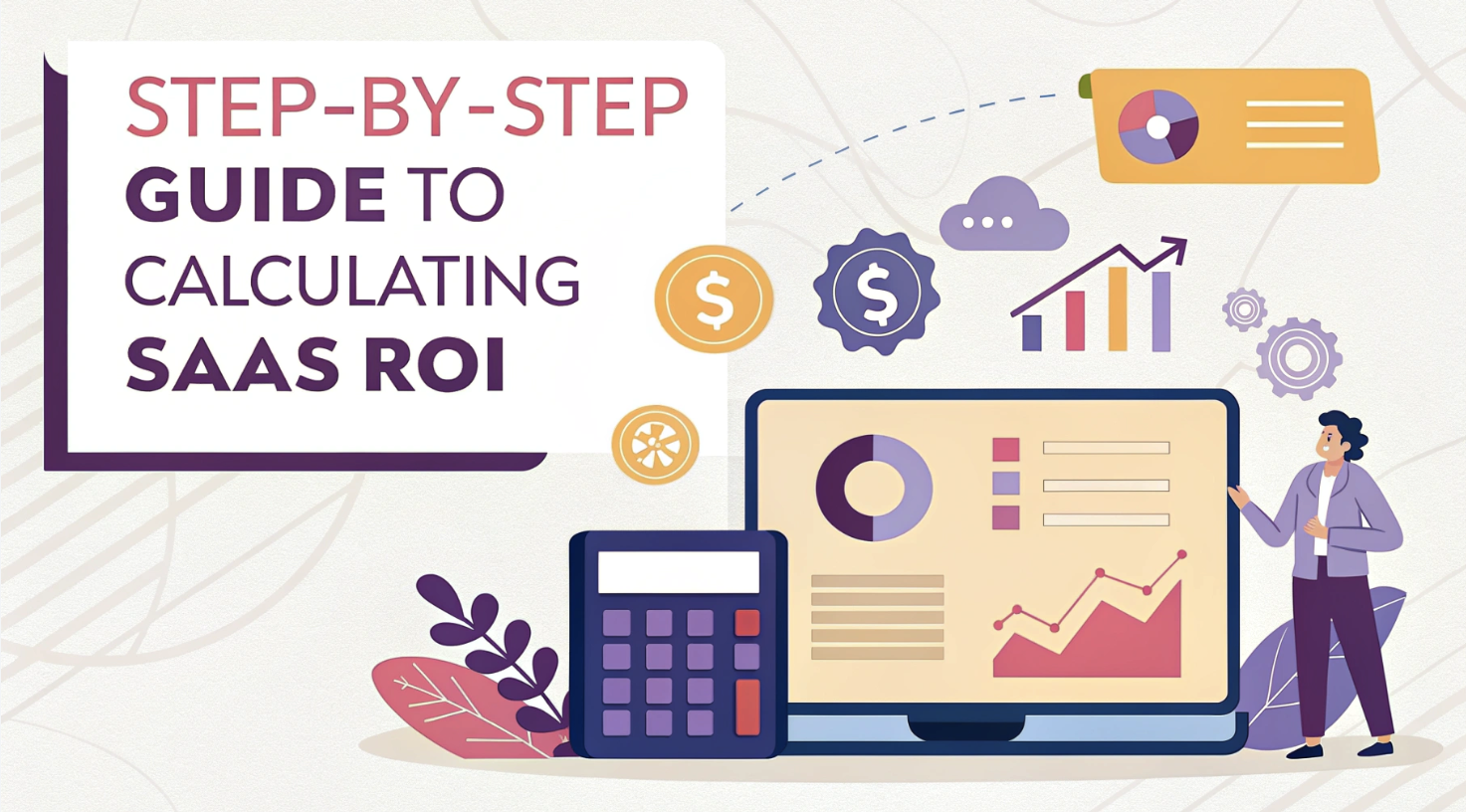
Understanding the return on investment (ROI) for SaaS solutions is crucial for businesses seeking to make informed, data-driven decisions. Calculating SaaS ROI ensures that every dollar spent on software delivers measurable value. However, manual calculations often lead to errors due to overlooked costs or benefits.
A SaaS ROI calculator mitigates this risk by breaking down key components, such as upfront costs, ongoing expenses, efficiency gains, revenue increases, and cost reductions, into a clear and structured format. This approach not only improves accuracy but also saves time, enabling businesses to focus on optimizing their software investments.
Understanding SaaS ROI
What Is SaaS ROI?
SaaS ROI measures the income generated from a software investment compared to its associated costs. It serves as a critical metric for evaluating how effectively software contributes to achieving business goals. This evaluation goes beyond financial gains, encompassing non-monetary benefits like improved customer satisfaction and enhanced productivity.
Businesses often use SaaS ROI to determine whether their software investments align with their strategic objectives.
When calculating software ROI, it’s essential to consider both anticipated and actual ROI. Anticipated ROI helps forecast potential benefits before implementation, while actual ROI evaluates the realized value post-deployment. This dual approach enables businesses to evaluate the effectiveness of their investments and make informed decisions about future software purchases.
Why SaaS ROI Matters for Business Success
Measuring marketing ROI, particularly for SaaS solutions, is vital for driving business success. It improves decision-making by providing clear insights into the value of software investments. Companies can enhance productivity and boost employee engagement by identifying tools that streamline operations.
Additionally, SaaS marketing ROI plays a significant role in increasing revenue by highlighting cost-effective solutions and operational efficiencies.
ROI analysis also helps stakeholders allocate resources wisely and justify development costs. For instance, understanding the anticipated and actual ROI of a SaaS tool can guide businesses in optimizing their software portfolios. Moreover, analyzing SaaS marketing ROI reveals how these tools accelerate sales cycles, improve customer retention, and enhance service delivery. This comprehensive evaluation demonstrates the direct and indirect impacts of software on profitability.
Challenges in Measuring SaaS ROI
Businesses often face several challenges when measuring marketing ROI for SaaS solutions. Adoption rates significantly influence ROI, as the effectiveness of a tool depends on how well users adopt and utilize it. Training costs and learning curves can also impact ROI, especially when extensive resources are required to onboard employees. Customization and integration costs present another hurdle, as tailored features may increase value but also inflate expenses.
Subscription flexibility further complicates ROI calculations. Usage-based pricing models can lead to fluctuating costs, making it harder to determine the software’s true value. Lastly, support and maintenance play a crucial role in sustaining ROI. Without adequate updates and support, the long-term benefits of SaaS tools may diminish, negatively impacting overall profitability.
Failing to address these challenges can result in missed opportunities for cost savings and operational inefficiencies. Businesses may continue paying for underutilized features or redundant subscriptions, ultimately hindering strategic decision-making.
Calculating software ROI effectively requires a thorough understanding of these obstacles and a proactive approach to overcoming them.
Key Metrics for SaaS ROI Calculation
Total Cost of Ownership (TCO)
Understanding the Total Cost of Ownership (TCO) is essential when calculating software ROI. TCO encompasses all expenses associated with a SaaS solution over its lifecycle. These costs go beyond the subscription fee and include several components:
-
Software acquisition and licensing fees
-
Implementation services, such as data migration and third-party consulting
-
Management and maintenance, including internal administration and external support contracts
-
Customizations, integrations, and premium add-ons
-
Training and change management for employees
-
Downtime and infrastructure provisioning
Each of these factors contributes to the overall cost of a SaaS platform. For example, while subscription fees may seem straightforward, hidden costs like compliance management or security updates can significantly impact the final TCO.
Businesses must evaluate these elements to ensure their SaaS investments align with their financial goals.
Implementation and Maintenance Costs
Implementation and maintenance costs vary widely across SaaS platforms. Pricing models often influence these expenses. Tiered pricing structures, for instance, may limit access to essential features at lower levels, forcing businesses to upgrade as their needs grow. Flat-rate pricing simplifies budgeting but may lack scalability.
Additionally, hidden costs such as onboarding, customization, and compliance can inflate the total expense over time.
Maintenance costs also include ongoing updates, support, and the management of infrastructure. Neglecting these aspects can lead to inefficiencies or reduced returns. To maximize gains, businesses should plan for these costs upfront and choose SaaS providers that offer transparent pricing and robust support.
Returns: Revenue Growth, Time Saved, and Customer Retention
The returns from SaaS investments often extend beyond direct financial gains. SaaS platforms can accelerate sales cycles, improve customer retention, and enhance service delivery. For instance, faster sales cycles and increased uptime can lead to higher average order values.
Additionally, tools that provide data-driven insights enable smarter pricing strategies and better decision-making.
Customer retention is an essential metric; a high retention rate signals customer satisfaction and long-term value. Metrics such as Net Revenue Retention (NRR) gauge revenue growth over time, with values exceeding 100% showing positive progress. By emphasizing these measurable benefits, businesses can ensure their SaaS investments yield a solid return on investment.
ROI Formula: Calculating ROI Percentage
Calculating the ROI percentage for SaaS investments involves a straightforward formula that provides clarity on the profitability of your software. Here’s how you can calculate it step by step:
-
Determine Net Profit: Subtract all expenses from the total revenue generated by the software. For instance, if your SaaS solution generates $500,000 in revenue and incurs $350,000 in expenses, the net profit would be $150,000.
-
Calculate Total Investment: Add up all costs associated with the software, including development, marketing, and operational expenses. For example, if the total investment amounts to $750,000, this becomes your baseline.
-
Divide Net Profit by Total Investment: Divide the net profit ($150,000) by the total investment ($750,000). This calculation results in 0.2.
-
Multiply by 100 to Get the ROI Percentage: Multiply the result by 100 to express it as a percentage. In this case, 0.2 multiplied by 100 equals 20%. The ROI for this SaaS investment is 20%.
This formula streamlines the process of evaluating software ROI, enabling businesses to measure their returns effectively. A positive ROI percentage indicates that the software is delivering value, while a negative percentage signals potential inefficiencies or overspending. Regularly applying this formula ensures that your SaaS investments align with your financial goals and deliver measurable gains.
Role of Customer Lifetime Value (CLTV) in SaaS ROI
Customer Lifetime Value (CLTV) plays a pivotal role in understanding the long-term returns of SaaS investments. It provides a comprehensive view of the revenue a customer generates throughout their relationship with your business. This metric is crucial for evaluating customer profitability and informing resource allocation decisions.
CLTV becomes even more impactful when paired with Customer Acquisition Costs (CAC). Comparing these two metrics allows businesses to measure the ROI for each new customer. For example, if the CLTV significantly outweighs the CAC, it indicates a healthy return on investment.
This insight helps businesses optimize their marketing strategies and allocate budgets more effectively.
A strong CLTV-to-CAC ratio also highlights the efficiency of your SaaS platform in retaining customers and driving recurring revenue. SaaS solutions that enhance customer satisfaction and loyalty contribute to higher CLTV, reinforcing their value in ROI calculations.
By focusing on CLTV, businesses can ensure that their software investments not only generate immediate gains but also sustain long-term profitability.
Step-by-Step Guide to Using a SaaS ROI Calculator
Step 1: Identify and List All Costs
The first step in calculating software ROI is to identify and document all costs associated with your SaaS tools. This process ensures no expense is overlooked, providing a clear picture of your total investment. Here’s how I approach it:
-
Inventory SaaS Subscriptions: I create a detailed list of all SaaS tools used across departments, including their subscription costs and billing cycles.
-
Calculate Total Costs: I sum up the costs of all subscriptions consistently, regardless of whether they are monthly or annual.
-
Account for Users: I determine the total number of employees or contractors using these tools. This step ensures accuracy when calculating per-user costs.
-
Find the Cost Per Employee: Dividing the total SaaS cost by the number of users yields the average cost per employee.
-
Optimize Spending: I analyze the list to identify redundant or underutilized subscriptions. This step often reveals potential savings opportunities.
Implementing these steps not only helps me track expenses but also highlights areas where I can reduce costs and improve efficiency.
Step 2: Quantify Benefits and Returns
Once I’ve documented the costs, I shift my focus to the benefits and returns of the SaaS investment. This step involves evaluating both tangible and intangible gains.
-
I calculate ROI using a simple formula: subtract the initial investment from the final value, divide the result by the cost, and then multiply by 100.
-
I assess the Total Cost of Ownership (TCO) to ensure all expenses, from subscription fees to maintenance, are accounted for.
-
I evaluate key performance indicators (KPIs) like revenue growth, customer acquisition costs, and employee productivity.
-
I document baseline metrics before implementing the software. This allows me to measure improvements over time.
-
I use customized dashboards to track real-time metrics and conduct annual reassessments to identify trends.
This approach ensures I capture the full spectrum of benefits, from increased profits to operational efficiencies.
Step 3: Input Data into a SaaS ROI Calculator
With all costs and benefits quantified, I input the data into a SaaS ROI calculator. This tool simplifies the process by automating complex calculations and providing accurate results. Key data points I include are:
-
Upfront Costs: Initial investments like setup fees and training expenses.
-
Ongoing Costs: Recurring expenses, including subscription fees and maintenance.
-
Efficiency Gains: Time saved through automation and streamlined processes.
-
Revenue Increases: Improvements in customer satisfaction and sales.
-
Cost Reductions: Savings achieved by replacing traditional software with SaaS solutions.
The calculator processes this data and generates a clear ROI percentage. This insight helps me evaluate the software’s performance and identify areas for improvement.
Step 4: Analyze the Results
After inputting all the data into the SaaS ROI calculator, I take a step back to analyze the results. This stage is important for determining whether the software investment aligns with my business objectives. I follow a structured approach to ensure the insights are actionable and accurate.
-
Conduct Pre-Investment Analysis: I compare the calculated ROI with my initial expectations. This helps me determine if the software is delivering the anticipated benefits or if adjustments are needed.
-
Compare Multiple Solutions: I use the calculator to evaluate other SaaS platforms. This comparison highlights which solution offers the best long-term value and potential savings.
-
Monitor ROI Over Time: I don’t stop at a one-time analysis. Regularly reviewing the ROI ensures the software continues to meet evolving business needs.
-
Adjust Pricing Tiers and Features: If the results show underperformance, I explore modifying subscription levels or features to optimize returns.
Analyzing the results also involves identifying trends. For instance, if the ROI percentage improves over time, it indicates that the software is becoming more effective as employees adapt to it. On the other hand, a declining ROI might signal inefficiencies or underutilization. This process ensures I make data-driven decisions to maximize the value of my SaaS investments.
Step 5: Adjust for Business-Specific Factors
Every business operates differently, so I always tailor my SaaS ROI calculations to reflect unique operational needs. Several factors influence the final ROI, and I account for each one to ensure accuracy.
-
Adoption Rates: I assess how well employees or customers are using the software. High adoption rates typically lead to better returns.
-
Learning Curves and Training Costs: I factor in the time and resources spent on training. A steep learning curve can delay the realization of benefits.
-
Customization and Integration Costs: Custom features often enhance the software’s value but can increase costs. I weigh these expenses against the expected benefits.
-
Subscription Flexibility: I assess whether adjusting subscription levels can enhance ROI. Scalable pricing models often provide better long-term savings.
-
Support and Maintenance: I consider the quality of support and updates. Reliable maintenance ensures the software remains effective and delivers consistent returns.
Adjusting for these factors allows me to refine the ROI calculation and align it with my business strategy. For example, if training costs are high, I might invest in more user-friendly tools to reduce onboarding time.
Similarly, if adoption rates are low, I explore ways to improve engagement, such as offering additional training or incentives. These adjustments ensure my SaaS investments deliver maximum value.
Tips to Maximize SaaS ROI
Optimize Software Usage Across Teams
Maximizing software ROI starts with ensuring that every team uses the tools effectively. I always recommend monitoring software usage through analytics to identify underutilized features or unused licenses. This helps pinpoint areas where teams may need additional training or where costs can be reduced. For instance, gathering feedback from employees often reveals valuable insights into how the software aligns with their workflows.
Automation features also play a significant role in this process. These tools handle repetitive tasks, saving time and reducing errors. Integrating SaaS platforms with other tools further enhances efficiency by streamlining processes and minimizing manual work. Regular reviews of software effectiveness ensure that it continues to meet evolving business needs.
Automate Processes for Efficiency
Automation is one of the most impactful benefits of SaaS. It allows businesses to save time and focus on strategic initiatives. For example, automating repetitive tasks like data entry or report generation reduces errors and improves accuracy. This results in cleaner data and a more seamless user experience.
Scalability is another advantage of automation. SaaS solutions can handle increased workloads without compromising quality. Faster response times and fewer errors also enhance customer satisfaction, which directly contributes to higher ROI. I’ve seen businesses achieve significant efficiency gains by leveraging automation to streamline operations and improve productivity.
Regularly Review SaaS Performance and Costs
Continuous monitoring of SaaS performance is essential for optimizing investments. I always evaluate tools based on their contribution to revenue and productivity. This ensures that resources are allocated wisely. Regular reviews also help identify unused licenses or redundant features, which can be eliminated to improve ROI.
Adjustments based on performance evaluations are equally important. For example, if a tool underperforms, switching to a different pricing tier or exploring alternative solutions can maximize returns. Tracking metrics like adoption rates and user engagement ensures that the software remains aligned with business goals.
Negotiate Pricing or Upgrade Plans Strategically
Negotiating pricing or upgrading plans for SaaS tools requires a strategic approach. I always start by gathering as much information as possible about the vendor’s pricing structure and service-level agreements (SLAs). Understanding these details helps me ensure that the software delivers reliable service while providing a fair return on investment (ROI).
One of the most effective strategies I use is leveraging price benchmarks. Comparing what similar businesses pay for the same SaaS solution gives me a strong negotiating position. I also avoid disclosing my budget upfront. Keeping this information confidential allows me to negotiate better terms without revealing my financial limits.
When negotiating, I follow a structured process to maximize savings:
-
Start the conversation early. This allows me to gather information and apply pressure on vendors before deadlines.
-
Consider longer contracts. Vendors often offer discounts for multi-year agreements, which can significantly reduce costs.
-
Use benchmarks. Knowing what others pay for similar software ensures I don’t overpay.
I also explore opportunities to upgrade plans strategically. For instance, if my team’s needs have grown, I negotiate for additional features or higher-tier plans at a discounted rate. Vendors are often willing to accommodate these requests to retain long-term customers.
Negotiating effectively not only reduces costs but also improves the overall software ROI. By taking a proactive and informed approach, I ensure that my SaaS investments align with my business goals and deliver maximum value.
Tools for Simplifying SaaS ROI Calculations
Features of a Good SaaS ROI Calculator
A good SaaS ROI calculator should provide accurate and actionable insights to help businesses effectively evaluate their software investments. I always look for tools that include the following features:
-
Total Cost of Ownership (TCO): Covers all expenses from subscription to cancellation.
-
Implementation Cost: Accounts for setup fees and training expenses.
-
Time to Value (TTV): Measures how quickly benefits are realized.
-
Return on Time Saved: Quantifies productivity gains in monetary terms.
-
Customer Acquisition Cost (CAC): Tracks savings in acquiring new customers.
-
Customer Satisfaction: Evaluates how well the software meets user expectations.
-
Customer Retention Rate: Monitors the percentage of customers retained over time.
-
Impact on Referrals and Sales: Highlights contributions to customer referrals and sales growth.
Additionally, calculators should factor in upfront costs, ongoing expenses, and efficiency gains. These features ensure businesses can make informed decisions about their SaaS investments and achieve a good ROI in SEO and other areas.
Overview of SaaS SEO ROI Calculators
SaaS SEO ROI calculators are specialized tools designed to measure the return on investment for SEO-focused SaaS platforms. These calculators simplify the process of evaluating how SEO tools contribute to business growth. They typically assess metrics like revenue increases, cost reductions, and efficiency gains. For example, they can calculate the monetary value of improved search rankings or the time saved through automated keyword research.
I’ve found that these calculators are particularly useful for businesses aiming to achieve a good ROI in SEO. They provide clear insights into how SEO tools impact customer acquisition, retention, and overall profitability. By using a saas seo roi calculator, businesses can identify which tools deliver the best value and optimize their marketing strategies accordingly.
Recommended Software ROI Tools for Businesses
Choosing the right software ROI tool can significantly simplify the calculation process. Here’s a comparison of some of the most recommended tools:
|
Tool Name |
Key Features |
Pros |
Cons |
G2 Rating |
Pricing |
|---|---|---|---|---|---|
|
Google Analytics |
Real-time data tracking, Detailed reporting, Milestone tracking, Goal setting, Customizable dashboards |
Free, Easy to use, Real-time data, Multiple websites |
Anonymous data, Learning curve |
4.5/5 |
Free |
|
Cyfe |
White-labeling, All-in-one dashboard, Pre-built widgets, Historical data |
Affordable, Pre-built widgets, Real-time reports |
Data erasure risk, Limited widgets |
4.3/5 |
Starts at $19/month |
|
Kissmetrics |
Revenue tracking, Customer journey tracking, Page views, Bounce rate |
Identifies revenue sources, Tracks customer journey |
Limited to email marketing |
N/A |
N/A |
These tools cater to different business needs, from tracking SEO performance to analyzing customer journeys. For businesses focused on SEO, a saas seo roi calculator like Google Analytics can provide valuable insights into how their efforts translate into measurable returns.
Understanding and calculating ROI for SaaS investments is essential for making informed business decisions. A clear ROI analysis reveals the financial impact of software solutions, helping businesses optimize spending and focus on high-performing tools.
I always recommend using a saas roi calculator to simplify this process. It eliminates guesswork and provides accurate insights into costs, benefits, and overall returns. Applying the outlined steps ensures businesses can maximize their software roi.


